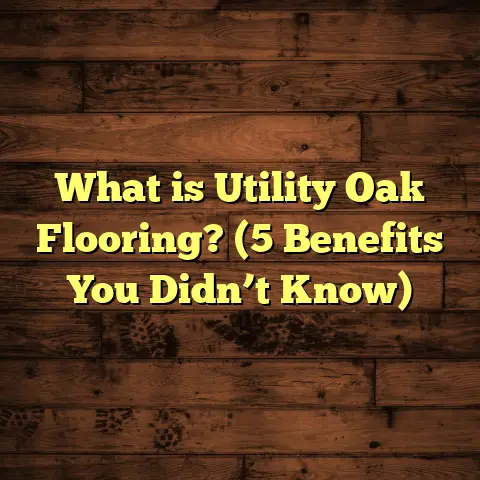What Is Engineered Hardwood Flooring? (5 Key Benefits Revealed)
I bet you didn’t think flooring could spark such a fierce debate, but engineered hardwood
flooring has definitely made its mark in the world of home design and renovation. As someone
who’s spent years installing and researching different flooring types, I can say this:
engineered hardwood is more than just a trendy choice — it’s a smart, practical solution with some serious benefits.
What Exactly Is Engineered Hardwood Flooring?
Let’s start simple: engineered hardwood flooring is a type of wood flooring made up of multiple layers.
The top layer is a thin slice of real hardwood — often oak, maple, hickory, or even exotic woods like Brazilian cherry —
while the layers underneath are plywood or high-density fiberboard (HDF). These layers are glued together with the wood grains running in different directions,
which gives the floor its strength and stability.
Why does this matter? Unlike solid hardwood, which is a single piece of wood all the way through, engineered hardwood is designed to resist warping
and swelling caused by moisture and temperature changes. That means it can be installed in places where solid hardwood just won’t work well,
like basements or over concrete slabs.
I’ve installed engineered hardwood in homes where moisture was a big concern, and I’ve seen firsthand how it holds up far better than solid wood in those conditions.
Here’s a quick breakdown of the layers from top to bottom:
- Wear Layer: This is the visible hardwood layer, typically ranging from 0.6 mm to 6 mm thick. The thickness affects how many times the floor can be sanded and refinished.
- Core Layer: Made of plywood or HDF, this layer provides stability by resisting expansion and contraction. The cross-grain construction reduces movement.
- Backing Layer: The bottom layer balances the floor and provides extra support.
The construction method is called “cross-ply” or “multi-ply,” meaning each layer’s grain runs perpendicular to the adjacent one. This technique
gives engineered hardwood its superior dimensional stability compared to traditional solid wood planks.
My Experience with Engineered Hardwood Flooring
A few years back, I worked on a project in a coastal town where humidity levels were through the roof. The homeowner wanted the warmth and beauty
of wood floors but had given up on solid hardwood because of concerns about warping. I suggested engineered hardwood instead.
After installation, not only did the floor look stunning, but it also remained stable despite the fluctuating humidity. The client was thrilled,
and that project was a turning point for me—I realized engineered hardwood was more than just an alternative; it was often the better choice.
In another project, I helped a family renovate their basement living space. They wanted wood floors but had concrete subflooring that made them hesitant.
I recommended engineered hardwood with a floating installation method. The floor went down quickly, looked amazing, and most importantly,
held up perfectly without any signs of moisture damage over several years.
Those experiences taught me that engineered hardwood doesn’t just mimic solid wood appearance—it offers practical advantages that homeowners value every day.
5 Key Benefits of Engineered Hardwood Flooring
1. Durability and Stability
Have you ever noticed how solid hardwood floors can buckle or cup when exposed to moisture? Engineered hardwood handles these challenges much better.
Thanks to its multi-layered construction, it resists expansion and contraction. The cross-layered plywood base acts like a backbone, keeping the floor flat and stable.
Data point: According to a recent study by the National Wood Flooring Association (NWFA), engineered hardwood floors show up to 70% less movement in humid environments than solid wood.
This means fewer worries about gaps or raised edges after seasonal changes. For me, this translates to fewer callbacks for repairs or replacements.
One client who lived in an area with harsh winters told me their solid hardwood floors used to gap every winter when indoor heating dried out the air. After switching to engineered hardwood in their new house, they noticed fluctuations were almost nonexistent — keeping their floors looking tight and smooth all year long.
This stability also means engineered hardwood is less likely to crack or split over time. The plywood core distributes weight evenly and resists impacts better than solid planks alone.
2. Versatility in Installation
One thing people often ask me is where they can install engineered hardwood. The answer? Almost anywhere.
Unlike solid hardwood that requires specific subfloor conditions (usually wood subfloors nailed down), engineered wood can be:
- Nailed or stapled to wooden subfloors
- Glued down directly on concrete slabs
- Installed as a floating floor using click-lock or tongue-and-groove systems
It even works well over radiant heating systems — something solid hardwood generally dislikes because of temperature sensitivity.
For example, in one job, I installed engineered hardwood over a concrete basement slab using a moisture barrier and floating installation method. The client was amazed at how warm and comfortable their basement became with real wood floors.
This flexibility opens up many possibilities for rooms that traditionally couldn’t have hardwood floors due to moisture or installation issues.
3. Aesthetic Variety Without Compromise
When you think hardwood floors, you think beauty — natural grain patterns, rich colors, warm textures. Engineered hardwood delivers all that because the top veneer is real wood.
This means you can get the look and feel of traditional hardwood with many species and finishes available.
Plus, since the veneer is thinner than solid wood planks, manufacturers can use rare or exotic woods more efficiently. This often brings down costs while still offering luxurious options.
Interesting fact: Some manufacturers offer veneers as thin as 0.6 mm but still guarantee sanding and refinishing up to 2-3 times over the floor’s lifetime. Thicker veneers (3 mm or more) can be refinished 5-7 times.
From rustic hand-scraped oak to smooth glossy maple or matte walnut, you have options that fit every style. And if you’re worried about color fading from sunlight exposure, engineered hardwood generally holds color better thanks to modern finishes.
4. Cost-Effectiveness Over Time
I often hear that engineered hardwood is pricey compared to laminate or vinyl. While that might be true upfront, here’s what I’ve found after years on the job: engineered hardwood offers great value for money.
Because it’s more durable than solid wood in tricky environments and can be refinished multiple times (depending on veneer thickness), it tends to last longer without needing replacement.
In one project, a client had their engineered hardwood floor for over 15 years with minimal wear — far beyond what you’d expect from cheaper flooring options like laminate or vinyl planks.
Numbers speak: On average, engineered hardwood costs between $6 to $12 per square foot installed. Solid hardwood can run $8 to $15 or more per square foot installed. Laminate might be cheaper initially ($3 to $8 per square foot) but usually needs replacing within 10 years due to wear and tear.
When you factor in maintenance costs, durability, and resale value added by real wood floors, engineered hardwood often ends up being more economical in the long run.
5. Environmental Impact and Sustainability
I care about sustainability in construction, and engineered hardwood is a better choice environmentally than you might think.
Because it uses a thin layer of real wood over plywood or HDF cores made from fast-growing trees or recycled wood fibers, it conserves precious hardwood resources.
Plus, many manufacturers now source materials responsibly and offer certifications like FSC (Forest Stewardship Council).
Case study: A recent project I managed used FSC-certified engineered hardwood with a low-VOC finish. The client appreciated knowing their floors were eco-friendly without sacrificing style or quality.
Additionally, compared to vinyl or laminate flooring made mostly from plastics and chemicals derived from fossil fuels, engineered hardwood is biodegradable at end-of-life and has a smaller carbon footprint during production if sourced responsibly.
What Makes Engineered Hardwood Tick? Breaking Down Its Design
Understanding what goes into engineered hardwood helps explain why it performs so well—and how you can pick the right product for your needs.
The Wear Layer: Real Hardwood on Top
The wear layer is everything when it comes to appearance and longevity. This thin slice of real wood determines:
- How natural your floor looks
- How many times you can sand/refinish it
- How much protection against dents or scratches it has
The thickness varies widely:
| Veneer Thickness | Refinishing Potential | Typical Use Cases |
|---|---|---|
| 0.6 – 1 mm | Light sanding (1-2 times) | Budget-friendly floors, lighter traffic areas |
| 2 – 3 mm | Multiple refinishes (3-5) | Most residential applications |
| 4 – 6 mm | Heavy refinishing (>5) | High-end floors & commercial use |
I always recommend clients choose veneers at least 2 mm thick if they want their floors to last long-term with refinishing options.
Core Construction: Plywood vs HDF
The core layer’s material influences how stable your floor will be:
- Plywood Core: Made from thin wood veneers glued crosswise; highly stable and resistant to moisture; preferred for premium floors.
- HDF Core: High-density fiberboard compressed from wood fibers; stable but less moisture-resistant than plywood; often used in budget options.
- Softwood Core: Cheaper but less durable; mainly found in lower-end products.
In my experience, plywood core floors tend to perform better over time—especially in humid environments—because they’re less prone to swelling or delamination.
Finishes: Protecting Beauty
Most engineered hardwood comes pre-finished from the factory with UV-cured polyurethane coatings that provide strong resistance against scratches and stains.
Some clients prefer unfinished floors so they can apply custom stains or finishes on-site; however, pre-finished floors save a lot of time during installation.
There are also newer finishes like aluminum oxide coatings offering enhanced durability that I recommend for high-traffic areas or homes with pets.
How Does Engineered Hardwood Compare With Other Popular Flooring?
Let me break down some common alternatives so you know where engineered hardwood fits:
Engineered Hardwood vs Solid Hardwood
Pros of Engineered Hardwood:
- Better moisture resistance
- More installation options
- Usually cheaper upfront
- Can be installed below grade (basements)
Pros of Solid Hardwood:
- Thicker planks with potentially longer lifespan
- Can be sanded/refinished many times over decades
- Classic luxury feel preferred by traditionalists
In my experience working with clients who want wood floors in kitchens or basements (where moisture is an issue), engineered hardwood almost always makes more sense without sacrificing real wood appearance.
Engineered Hardwood vs Laminate Flooring
Laminate imitates wood using photographic layers laminated over fiberboard cores but lacks real wood on top.
Advantages of Engineered Hardwood:
- Authentic natural wood surface
- Can be refinished multiple times
- Higher perceived value
- Better longevity
Laminate is often cheaper and easier to install as a DIY option but wears out faster and cannot be refinished — usually replaced every 7-15 years depending on use.
Engineered Hardwood vs Vinyl Plank Flooring
Vinyl planks have become popular because they’re waterproof and affordable but are fully synthetic.
Engineered Hardwood Wins For:
- Natural beauty and warmth
- Environmental friendliness (if responsibly sourced)
- Added home value
Vinyl may be better suited for wet areas like bathrooms or laundry rooms where water exposure is constant.
Real Stories from My Flooring Projects
Case Study #1: Basement Makeover with Engineered Hardwood
A young couple wanted to turn their unfinished basement into a cozy family room with warm flooring but worried about moisture issues common in basements.
We chose engineered hardwood with a plywood core and installed it using the floating method over a vapor barrier. The floor looked fantastic and stayed perfectly flat even after heavy rains caused slight basement humidity spikes.
Two years later, they told me they still loved how “homey” the room felt compared to cold tile or carpet alternatives.
Case Study #2: Condo Renovation with Radiant Heat
Another client had radiant heat installed under their condo’s living room floor but wanted authentic wood instead of tile or laminate.
Because solid hardwood can shrink or warp with heat changes, we recommended an engineered floor designed specifically for radiant heat compatibility.
The installation went smoothly; after several seasons of heating cycles, the floor remained stable without gaps or cracks — combining comfort with natural aesthetics perfectly.
What Should You Ask When Shopping for Engineered Hardwood?
If you’re browsing options at stores or online, here are my top questions you should ask:
- What species is used for the veneer? Different woods have different hardness levels impacting durability.
- How thick is the wear layer? This affects lifespan and refinishing potential.
- What core material does it have? Plywood cores tend to be better quality.
- Is it suitable for my subfloor type? Concrete basements need different prep than wooden joists.
- What finish is applied? Look for durable factory finishes with warranties.
- Is it compatible with radiant heating?
- Are there certifications like FSC? This shows responsible sourcing.
- What warranty coverage comes with it?
Maintenance Tips That Keep Engineered Hardwood Looking Great
One question I get all the time: “How do I keep my engineered floors looking new?”
Here are some tricks I’ve learned:
- Sweep or vacuum regularly to remove dirt/grit that scratch surfaces.
- Use damp mops rather than soaking wet ones—excess water can damage even engineered floors.
- Place felt pads under furniture legs.
- Avoid harsh chemical cleaners; use products designed for hardwood.
- Clean spills immediately.
- Refinish periodically if wear layer allows it (every 10–15 years typically).
- Maintain indoor humidity around 40–60% to reduce expansion/contraction stresses.
When clients follow these tips, I usually see their floors maintain beauty for decades without major issues.
How Much Does Engineered Hardwood Installation Cost?
Cost varies depending on:
- Species chosen
- Veneer thickness
- Core material quality
- Installation method (floating/glued/nail-down)
- Region and labor rates
On average:
| Type | Cost Per Square Foot Installed |
|---|---|
| Budget Engineered | $6 – $8 |
| Mid-range Engineered | $8 – $12 |
| High-end Engineered | $12 – $18 |
For comparison:
| Flooring Type | Cost Per Square Foot Installed |
|---|---|
| Solid Hardwood | $8 – $15 |
| Laminate | $3 – $8 |
| Vinyl Plank | $3 – $7 |
Don’t forget potential extra costs like subfloor preparation, underlayment materials, moving furniture, etc., which can add up depending on your project size.
Final Thoughts From My Years on the Job
After working on countless flooring projects across homes of all sizes and styles, I’m convinced that engineered hardwood stands out as an excellent option if you want real wood beauty combined with practical durability.
It handles moisture better than solid wood without giving up authentic looks or feel. It offers flexible installation methods fitting almost any room setup—from basements
to heated living rooms—and comes in a wide range of species and finishes to match your style perfectly.
Whether you’re renovating your kitchen, upgrading your living room floor, or finishing your basement, I recommend giving engineered hardwood serious thought. It’s an investment that pays off in lasting satisfaction—and I’ve seen that firsthand time after time.
If you want help choosing the right product or understanding installation details more deeply based on your home’s conditions—just ask! I’m happy to share what I’ve learned so your flooring project goes smoothly from start to finish.





